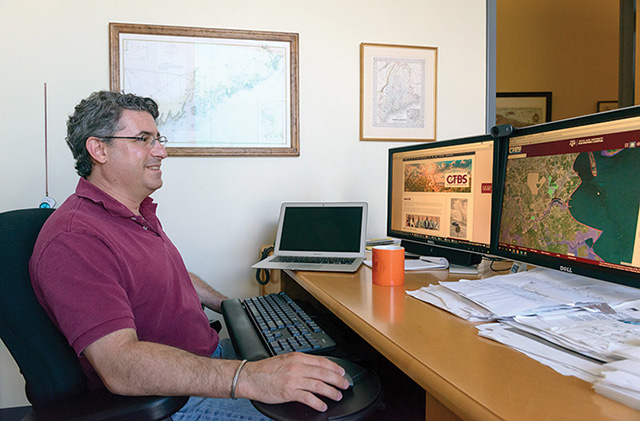Dr. Brody and CTBS Lead Response to Hurricane Harvey
TweetBy Patrick Temperilli
Academic Affairs
By the time Harvey hit the Houston and Galveston area, it had ceased to be the monstrous category 5 hurricane that seemed to erase the entire Gulf of Mexico from radar maps. Strong winds weren't the concern for the region at that point. The amount of rain the storm would bring was much more of a worry, and it had been for some time. The memory of the flooding that tropical storm Allison had brought to the area, about 15 years prior, was still in many Houstonian's minds.

"This was a heartbreaker for me. I knew that this would happen, but I didn't know when. We've been talking about it for years," said Dr. Sam Brody, the director of the Center for Texas Beaches and Shores (CTBS) and a professor in marine sciences at Texas A&M at Galveston (TAMUG). When CTBS was established on the Texas A&M Galveston campus in 1993, the goal was for it to be a center for research "on coastal sustainability and resiliency." In the immediate aftermath of Harvey, it was difficult to see how anything could be resilient following an event that rained 9 trillion gallons of water in a few days, which is enough water to fill two square miles two miles high.
Most of the conversations about coastal resiliency have taken place at CTBS, and Dr. Brody is most often leading these conversations. CTBS is a dynamic and evolving center that appears to be growing both in size and, most importantly, influence. With work addressing the impact of Hurricane Ike in 2008 and now Harvey, CTBS is considered more seriously by people in state government as a source of research and policy solutions to a deluge of challenges. Being located on the campus of Texas A&M Galveston allows for a unique environment that only makes the program more successful. "CTBS is made up of core faculty from different departments, on this campus and in College Station," says Brody. By fostering a collaborative environment with students, the work is partner-based. This provides students with the opportunity to become full team-members, where they receive the best in support and training. The students are recognized for their contributions in subsequent publications. "We actively recruit the best students in the country to work on the type of projects we do. It's been a model of success. Student-driven, faculty-led collaborative research that is interdisciplinary, bringing together different perspectives and fields to look at these intractable problems related to coastal resiliency."
For Dr. Brody, Harvey hit close to home. "I'm obsessed with flooding", he said. "Houston is a poster child for flooding. My wife and I recently bought a home in Houston. My wife looked at granite countertops and bedrooms and I looked at drainage and street elevation. I was confident we were not going to flood." But an event on the magnitude of Harvey can damage confidence as well as homes. "Now, our streets flooded, but they are designed to flood. But once the water jumped the curb and started climbing the lawn, and I saw how serious it was for our area, then I knew hundreds of thousands were going to suffer. I called my colleague and best friend, Wes Highfield (also a professor in Marine Sciences at Texas A&M Galveston), and I said 'This is going to be bad.'"
Bad it was. While the aftermath of the storm has shown no shortage of resiliency in the people of the greater Houston area, Dr. Brody gives the impression that it should not come down to this. "A lot of people didn't know the risk. Part of my job is to articulate and develop tools to give to residents and prospective homebuyers the chance to make more informed decisions. They don't have access to the data I do." In order to address this disparity in information access, Brody has developed a freely-accessible online tool called Buyer B-Where.
Brody is a big-picture guy, and that focus helped this tool be born. "I developed it with my former graduate student, who is now a professor at the University of Washington. We did this in a weekend. I originally developed it outside the university, but we decided we had to get this out so people could use it."
Dr. Brody is clearly proud of the Buyer B-Where system capabilities, which is available at http://txbuyersbewhere.com, and it's easy to see why. He is able to look at any property on a map, which is reminiscent of Google Earth or a property buying site. However, Buyer B-Where offers risk scores for different hazards for each searched property. Looking at some property in the Meyerland area, Buyer B-Where reveals a risk factor that is maxed out for flooding. Meyerland has been no stranger to catastrophic flooding over the past few years. According to Brody, this highlights the problem perfectly. "I've got all this data. Something's wrong that people wouldn't know this. A realtor would never say anything. Why can I see my school ratings and crime stats on Zillow but I can't see my flood risk rating?"
Brody is hopeful that this access to pertinent information will transform the future of Houston and the fortunes of those that live there. "Over time, rather than regulate our way out of this, the marketplace may take care of itself, and the people, if they have the information, can make more informed decisions. Rather than flood prone homes, they will end up buying flood proof homes."
Meanwhile, the work being done at CTBS is now seen as paramount by those previously less concerned with coastal sustainability. Dr. Brody is a busy man who never stands still for long, and as politicians in Austin seek to address the resiliency of the Texas Gulf Coast through projects and policy, he and CTBS are already in high demand for the foreseeable future.
###